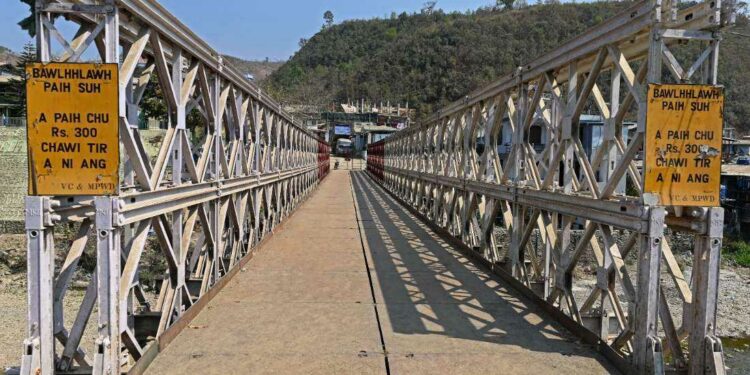The decision last month by India’s federal government to “seal” the open border with Myanmar will mainly impact indigenous tribes in the northeast region such as Nagas and Mizos, most of whom are Christians and share ethnic affinity and kinship ties that cut across political borders.
There were angry outbursts by most tribal people but many sought to clarify that they “would not like to be seen as causing hurdles” in India’s effort to secure its border.
Leaders of indigenous people’s groups and rights activists met in Dimapur, a commercial city in Nagaland state, on Feb. 16 and condemned the decision to do away with “free movement” across the Myanmar border.

“The decision to do away with the Free Movement Regime (FMR) and erect border fencing is not only impractical and dehumanizing to the communities living on both sides of the border but, such an approach may only diminish the prospects for peace and wellbeing in the restive region,” they stated in a letter sent to Prime Minister Narendra Modi.
Officials in the federal Ministry of Home Affairs said the FMR was scrapped to ensure “the internal security of the country and to maintain the demographic structure” in the northeastern states.
India and Myanmar agreed in 1950 to allow “natives to move freely” into each other’s territories without passports or visas along the 1,643-kilometer land border covering four Indian states — Mizoram, Nagaland, Manipur, and Arunachal Pradesh.
The 1950 pact underwent several changes over the years, and in 2004, India decided to limit free movement to just 16 kilometers.
In 2018, the two countries signed an Agreement on Land Border Crossing to “facilitate regulation and harmonization of already existing free movement rights for people ordinarily residing in the border areas of both countries.”
That effort seems to have come to naught with the Indian government’s latest decision. Its full impact on people can be felt in Longwa village in Nagaland state, which shares a 215-kilometer border with Myanmar’s Sagaing Region.
The village’s estimated population of 7,500 people virtually enjoyed “dual citizenship” all these years. Now, it stands threatened.
Some Naga inhabitants even claimed a threat to livelihood as their agricultural lands were in Myanmar. They lived in India but did their farming in Myanmar, they said.
“All these issues ought to be discussed and understood well,” said Wangnei Konyak, the village chief of Longwa.
He may be the village chief but the real influence rests with the Aangh (Naga king), whose traditional jurisdiction spread across three villages on the Indian side and five villages on the Myanmar side.
The 52-year-old Tonyei Phawang, who is a Konyak, the largest of the Naga ethnic groups, appeared pensive.
“My right hand is in Myanmar and my left is in India,” he said standing at the gates of his house. “The government of India’s decision to fence the border will divide my house.”
Phawang and Konyak are not in isolation. Many of their subjects feel the same. The women are especially worried about how this will impact their social and family lives.
The chief ministers of Nagaland and Mizoram have openly opposed the fencing of borders but their counterparts from Manipur and Arunachal Pradesh are keenly supporting it.
Over 87 percent of people in Nagaland and Mizoram are Christians while Manipur has over 41 percent and Arunachal Pradesh has around 30 percent Christians.
Manipur Chief Minister N Biren Singh, a Hindu, is said to have proposed fencing the border. His state has been engulfed by ethnic violence since May 3, 2023, between the majority Meitei Hindus and Kuki and Zo tribal people, who are mostly Christians.
At the height of the violence in Manipur, India’s powerful Home Minister Amit Shah blamed the influx of Kuki tribal people from Myanmar. This was creating “insecurity among the Meiteis,” he told parliament on Aug. 9, 2023.
Manipur officials said around 6,000 refugees from Myanmar have taken shelter in the state.
New Delhi readily agreed to CM Singh’s proposal perhaps because of its concern that the problem might just grow bigger.
The Nagas have long been demanding a “Greater Nagalim,” a homeland spread across contiguous Naga-populated areas, both in India and Myanmar.
Similarly, a demand for a “Greater Mizo land” has been raised by Mizo leaders since the 1980s.
Considering their demographic spread in the region, both Naga and Mizo communities may have a valid point in wanting to live in a common administrative area. But this is easier said than done considering the geo-political and security situations.
Nagaland Chief Minister Neiphiu Rio, a tribal Christian, while opposing the fencing option, said: “We have to work out a formula on how to solve the issues faced by people and also prevent infiltration” along the border.
He also visited Longwa in the remote Mon district on Feb 10.
But at a public function there, the chief minister alluded to the “free movement” of armed militant cadres and rebels from Myanmar who sneaked across the porous borders and sought “safe havens” in India.
“Freedom is not free… you are free only within the rules,” he told the people.
There exist border pockets in Mizoram and Manipur that are known for smuggling drugs and Chinese-made goods including cigarettes, besides the movement of armed militants.
Altogether, more than 31,000 people from Myanmar, mostly from the Chin state, have taken refuge in Mizoram following the military coup in the neighboring country in February 2021.
Mizoram’s Champhai district adjoining Myanmar witnessed the most — around 2,500 intrusions — from Haimual and Khawmawi in the Chin region in February 2022, officials said.
International issues and border management fall under the federal government’s responsibilities.
Mizoram Chief Minister Pu Laldumoma, also a tribal Christian who is against fencing the border, expressed his helplessness before the federal government.
“If it goes ahead with its plan, we have no authority and cannot stop it,” he said.
India’s federal government is also apprehensive of more refugees pouring in from Myanmar due to the junta’s announcement of a conscription law that makes military service mandatory for two years for men aged 18-35 and women aged 18-27.
The junta on Feb. 14 said it would draft 60,000 young men and women for military service. The call-ups would begin after the Thingyan New Year celebration in April. This has led to fear, defiance, and anxiety among young people and their families.
On Feb. 6, India’s Ministry of External Affairs issued an advisory for Indian nationals to not travel to western Myanmar’s Rakhine State. Those based there have been urged to leave immediately.
Security forces deployed in border areas of Nagaland and Mizoram are certain a fenced border will curb infiltration and also check smuggling activities.
But the complexities of the situation will continue.
In their letter to PM Modi, the tribal leaders pointed out that his government’s mantra has been Vasudhaiva Kutumbakam (one world, one family), but on the ground, it is perhaps “dividing families” at the borders using security as a justification for its actions.
“The security argument that your government has used to justify the removal of FMR stands in contradiction to the diplomatic and strategic outreach with neighboring countries and, more importantly, it violates the indigenous rights of the border communities,” the letter stated.
“We strongly oppose the security-centric approach to border management,” the tribal leaders said.
Credit: Source link




